If you are planning on getting a Pitbull, you may be interested in a rare tri color Pitbull. These dogs are starting to become very popular!
But what exactly is a tri color Pitbull. How do they differ from any other variety of Pitbull dogs?
Tri-Color Pitbull Temperament: Do They Make Good Family Pets?
The tri-color Pitbull’s behavior doesn’t really differ much from their solid-coated and bi-colored Pitbull cousins. They are warm, loving, and family-oriented.
They’re one of those dogs who knows how to put up a show for their friends. They love being inside the house and they are fairly easy to train.
Browsing Instagram will make you see how they typically look as well as their usual behaviors. They love to be inside the house most of the time, making them a perfect family pet. They’re also attentive and not very difficult to take photos with.
When it comes to training, a high patience level is a must. They are very intelligent but training must be consistent as they learn best that way.
Pitbulls are also very tolerant dogs. In the past, they were dubbed as one of the most aggressive canines because they were originally bred as fighters. If you want a sweet and loyal Pitbull, the key is in the training you give them as well as making sure that they don’t feel neglected or abused.
What Is A Tri Color Pitbull?
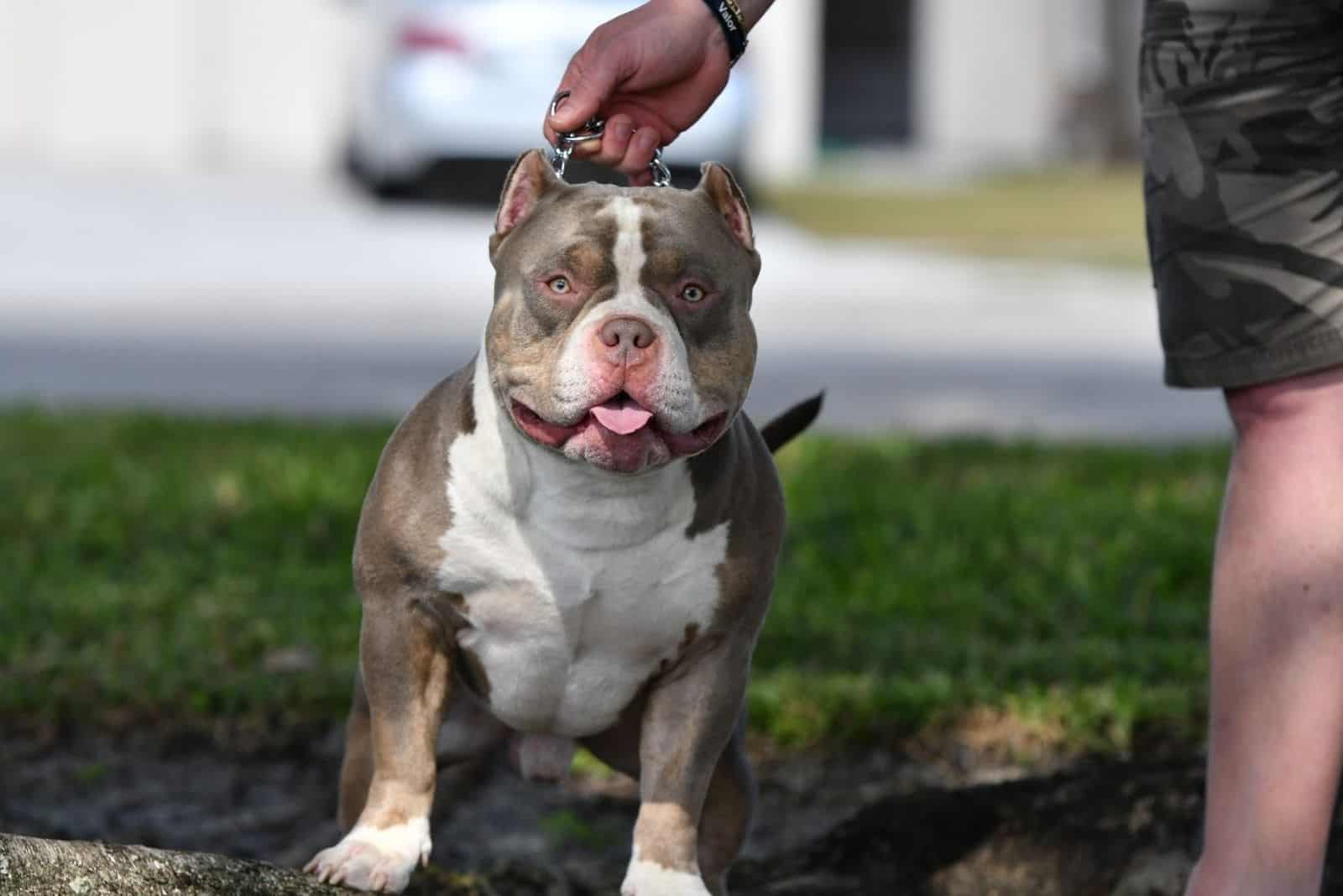
Tri color Pitbulls are Pitties with a unique color pattern that is fairly new in this breed. As their name suggests, they have three different hues on their medium to low-shedding coat.
Typically, they have one basic color that ranges anywhere between black and blue or lilac and two other shades that are usually white and tan.
As these dogs have become more and more popular in the past few years, breeders are creating as many color combinations as they can, especially as there are plenty of possibilities when you have three colors to work with.
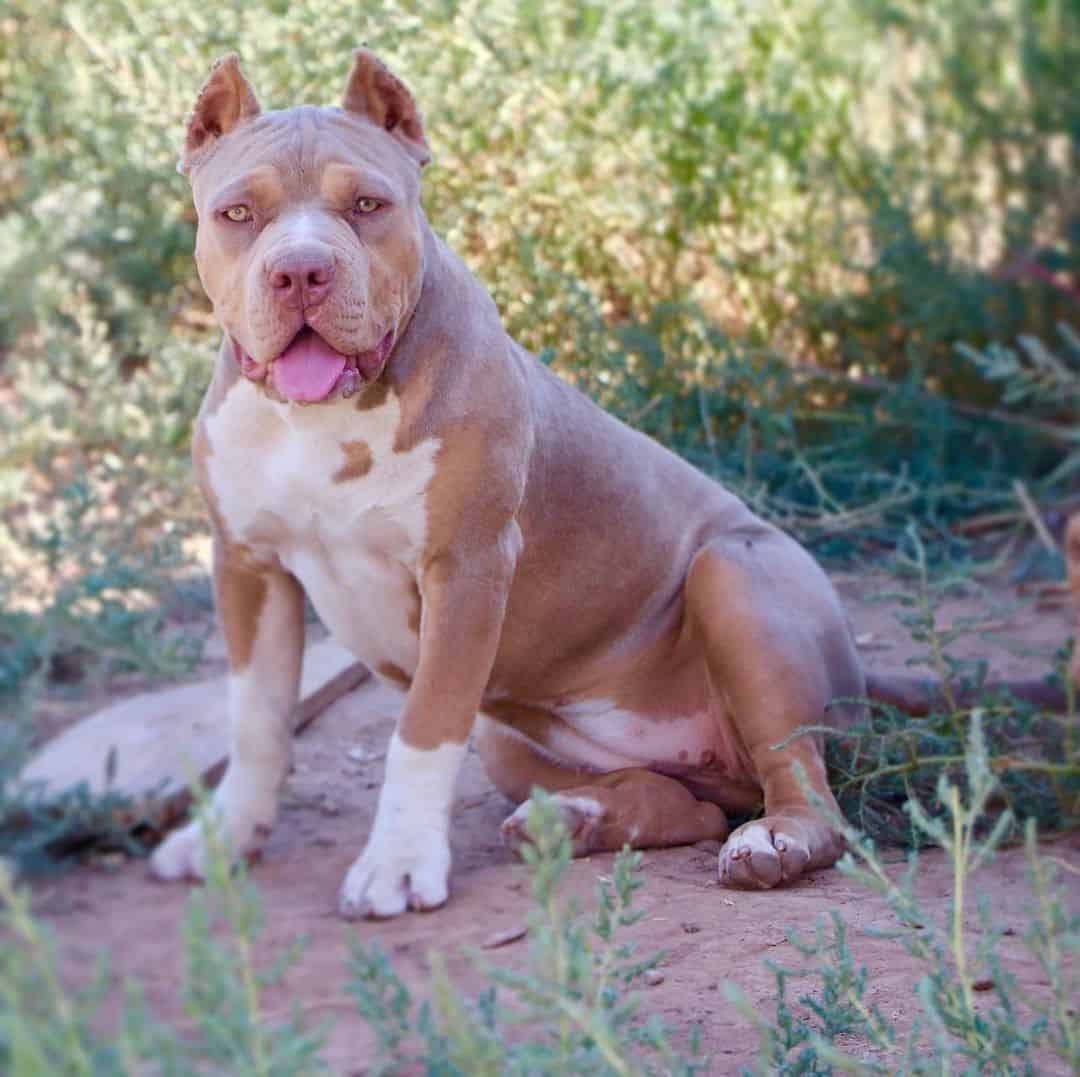
Photo from @dukecitypitbulls
Despite their growing popularity, tri color Pitbulls are somewhat rare. There are a few reasons behind this.
First off, most breeders avoid breeding tricolored Pits for several generations at a time. This is because these pups can be mistaken for mixed-breed dogs, and this is something breeders don’t want for their tri color Pitbull puppies.
This is especially true of Bully breeders, as these dogs are more valued for their pedigree than for the coat color they have – but more on this type of Pitbull later on.
Secondly, the genetics behind the tri color Pitbulls are somewhat complicated.
The color and pattern of a Pitbull’s coat are determined by Agouti genes. It depends on the variations of the Agouti locus alleles. The alleles that determine the main coat color are:
A allele – it causes the dominant black color that might be more or less diluted if the dilution gene is present. If an A allele is present, you’ll most likely get a black, blue, or chocolate puppy.
Ay allele – it produces the dominant yellow coat color. Typically, this allele is responsible for red and buckskin tri color Pitbulls.
At allele – this allele produces solid-colored tan point Pitbulls. This is a recessive gene, meaning it won’t express itself on the coat if one of the other two alleles is present.
Also, since recessive genes can stay hidden for generations, this means it might be difficult to know whether or not a pup is a carrier of the At allele.
These alleles have to be carefully matched to get a desired tri color puppy – not to mention that there is no guarantee that the same combination will produce two identically colored puppies!
Here are a few examples:
If your dog is tan and black, he has inherited an At allele from both of his parents. This is because the tan point gene is recessive, and there is no other way to get it.
A buckskinned or red dog inherited an At allele from one of its parents but the Ay allele from the other one.
On the other hand, a solid black color is caused by the mix of the A allele and At allele – but this is the same combination that makes solid blue or brown dogs.
As we’ve mentioned before, tri color Pitbulls come in a wide variety of colors. The colors and patterns are usually named after the base coat color – or rather, after the dominant color on their body.
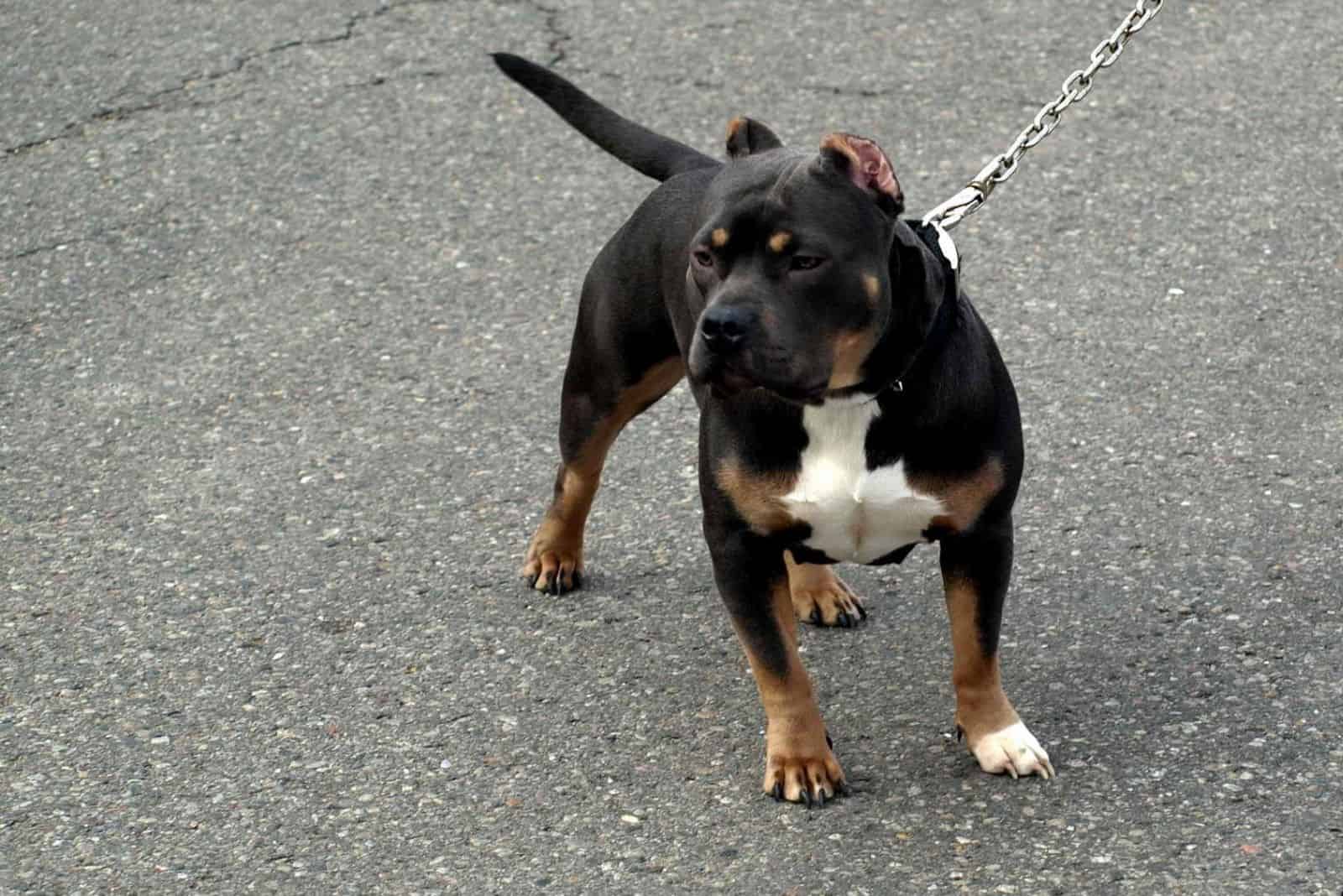
This is probably the most common main color in tri color Pitbulls. These pups have an almost solid black coat with two more colors (most likely white and tan) around their necks and on their legs.
Tan markings are usually above the dog’s eyes and nose, on their legs and chest, while the stomach and paws are typically white.
Chocolate tri color Pitbulls are quite common within the American Bully bloodlines. This is because many Bullies come in this base coat.
This is considered the ‘dullest’ coat combination of all the tri-colored dogs, as a Pitbull with this pattern simply looks as if it has three shades of the same color – the darkest one being chocolate and the lightest being white.
Still, these dogs are some of the more popular when it comes to the Pitbull breed.
Brindle dogs have the so-called ‘tiger stripes’ on their body. While typical brindle Pitbulls have most of their coat in brindle with a few white markings, tri color brindle Pitbulls include patches on the coat where the brindle isn’t present.
Depending on the main coat color, you can have blue brindle tri color Pitbulls, red brindle color Pitbulls, liver brindle color Pitbulls, etc.
These brindle markings aren’t always discernible, as some patterns make them more noticeable than others. However, if you look closely, you can always see stripes on some parts of these dogs’ bodies.
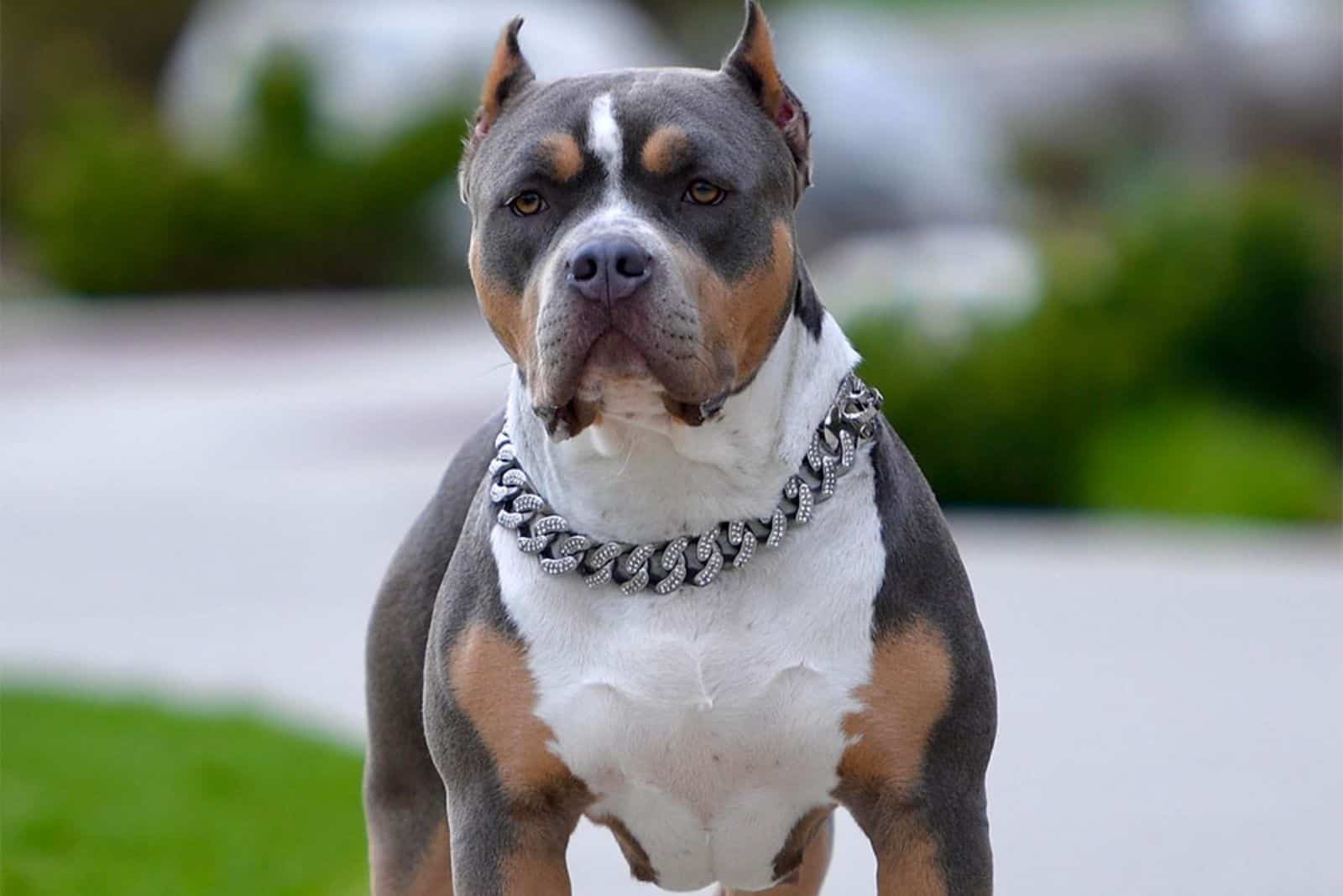
Blue tri color Pitbulls are somewhat common compared to other, more exotic colored coats.
Like most other tri-colored Pits, they mostly have tan and white markings on their heads, stomachs, and legs. Their base coat can vary anywhere between dark blue (that resembles black) and bright silver.
A fun fact is that these dogs will always be blue nose Pitbulls since the blue coat color always comes with a blue nose. If the dog’s nose is black or brown, the canine in question is a tan tri color Pitbull.
A purple tri color Pitbull has a gorgeous combination of colors on its coat. These pups have a purple (warm shade of blue) coat with tan and white markings on some parts of their bodies.
Purple Pitbulls have a coat that seems to be a somewhat warmer shade of blue. These pups’ markings are usually lighter than most other combinations, sometimes even in a champagne or warm grey color. The third color will almost always be white.
Unlike with blue tri color Pitbulls, these pups don’t have as visible tan markings, so they might appear to be only purple and white until you look at them closely.
Merle Pitbulls usually have more than three colors on their coats – but many people still put them under the tri color umbrella. In fact, most merle Pits have one base coat color (making them blue merles, red merles, fawn merles, and so on), that same color but diluted, and tan and white markings.
These markings are usually located on the same spot as with most tri color puppies – on their snouts, above their eyes, on their cheeks, chests, stomachs, and legs. These dogs also mostly have blue eyes or heterochromia.
It is important to note that merle is a very dangerous color that can lead to many health problems in all dog breeds, and not just Pitbulls. This is why most reputable dog breeders stay away from it.
This is because the merle pattern is the result of dilution genes that dilute the dog’s entire body, not just its coat color. This includes their skin, nerves, and heart. In fact, many homozygous merles (dogs that carry two merle genes) are entirely deaf or blind – or even both.
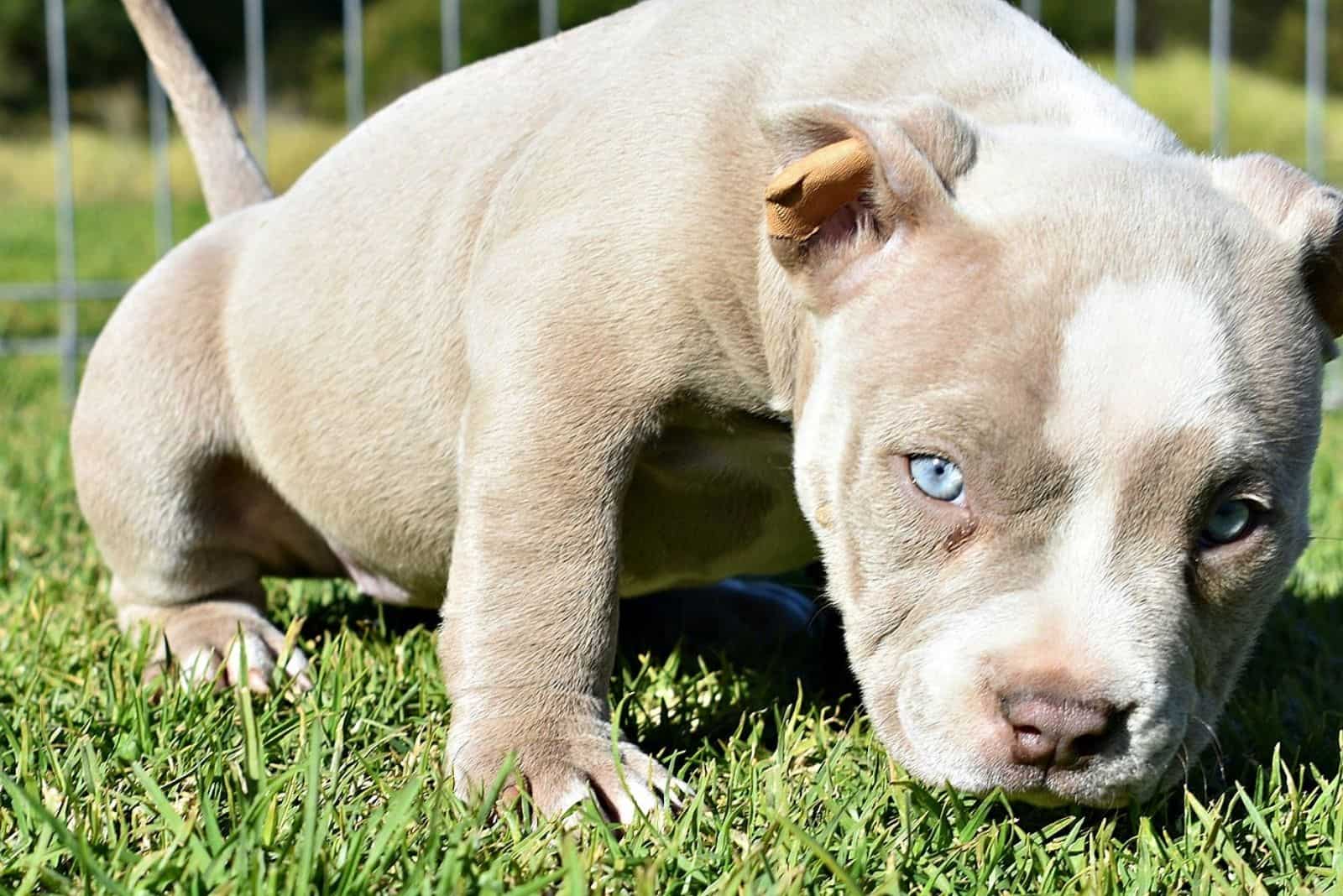
This is one of the rarest Pitbull colors, making this a unique tri color combination.
These dogs usually don’t have tan markings that are typical for most tri color Pitbulls. Instead, they have white markings and silvery-blue ones, making them a remarkably unusual sight.
Even if they do have tan markings, they are usually lighter in color, giving these dogs an overall gentle appearance.
Similar to fawn tri color Pitbulls, these dogs also have very gentle colorings and markings.
While the base of their coat is light beige or, rather, champagne in color, they sport white and tan markings. The tan markings don’t necessarily have to be lighter than the champagne, but they’ll always be warmer.
This is a rare color in Pitbulls, no matter the pattern.
Lilac tri color Pitbulls usually have most of their body covered in this color. However, they still have tiny tan and white patches, usually around the neck, snout, ears, hind legs, and paws, that indeed make them tri-colored.
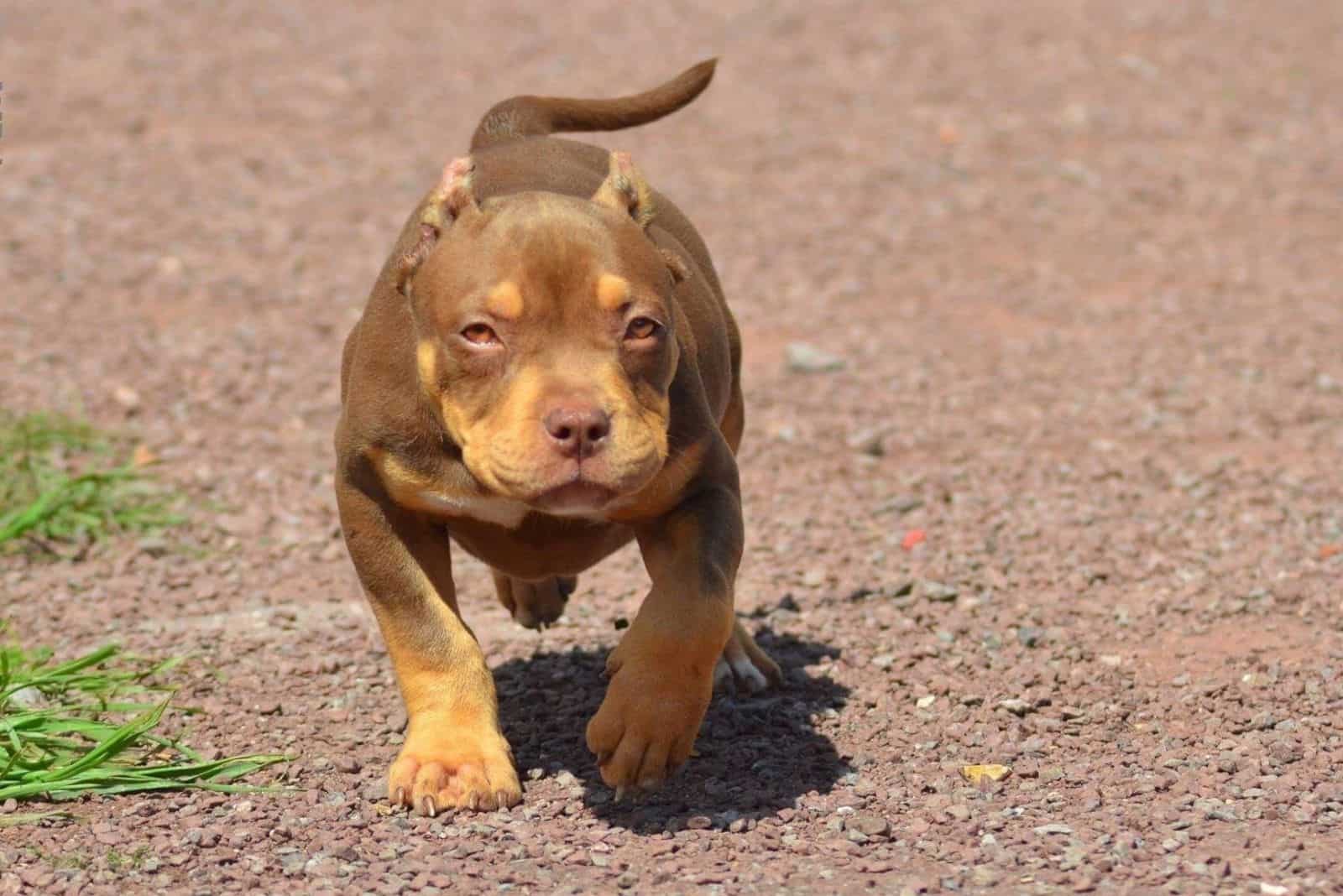
These dogs are very similar to the chocolate and purple tri color Pits, except their base coat color is in a lighter, reddish shade.
They usually have more white than tan markings, but exceptions do exist. The tan markings are typically located on their cheeks, above their eyes, and on their chests and legs.
White tri color Pitbulls can have any two of the other possible Pitbull colors on them – however, most of their coat will stay white.
There is some controversy about white tri color Pitbulls and other Pitbulls that have white as their primary coat color. This is because the lack of pigment that causes the white color is also connected with some health concerns such as blindness and deafness.
Also, white tri color Pitbulls can never be albinos, as dogs suffering from albinism have a pure white coat.
There is a difference between a white tri color Pitbull and a merle Pitbull. While white tri color Pitbulls have large patches of different colors, merles usually look splattered or spotty, and the colors aren’t sharply defined, as is the case with white tri color Pitbulls.
Similar to white tri color Pitbulls, these pups can be of any color; however, the primary color on their body will be tan. This means they’ll have white or cream markings and markings of a darker color – usually brown, but blue and black are also very common.
These dogs have a blueish-gray coat that looks almost silver. They also have white and cream markings (rarely tan, but they are possible).
This is one of the rarest combinations in tri color Pitbulls.
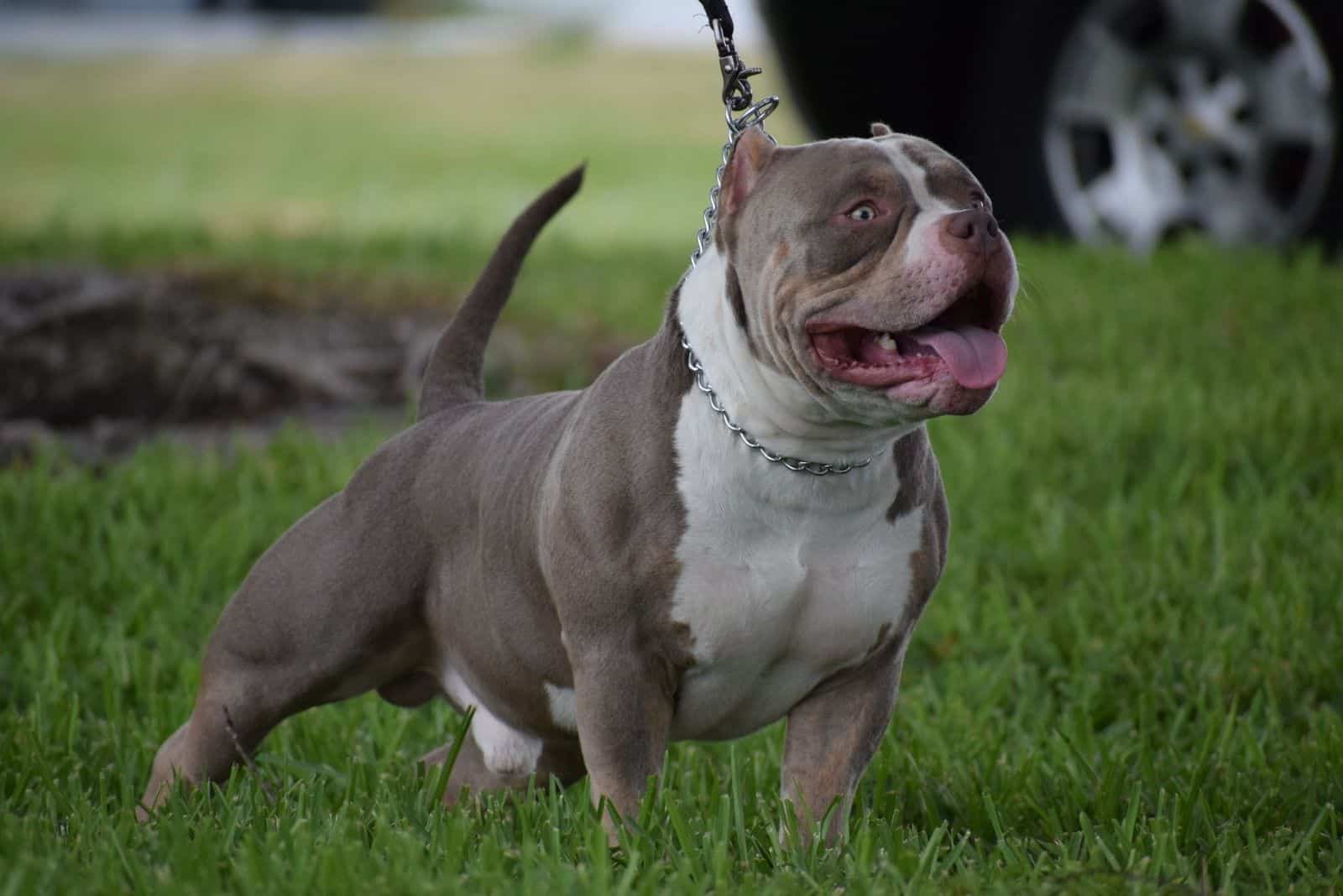
American Bullies are a group of so-called XXL Pitbull bloodlines recognized by the American Bully Kennel Club (ABKC) that produce dogs with a unique appearance. These dogs can come in many colors – but tri color isn’t the most popular.
These dogs are usually called tri color Bullies, and they can come in any pattern as regular Pitbulls can. Whether we’re talking about Texas Size Bullies or Pocket Bullies, all Pitbull colors are possible.
However, American Bully breeders aren’t partial to breeding dogs in this pattern. Bully Pitbulls tend to look like crossbreeds on their own, and the tri color pattern only worsens this impression.
Not just that, but since breeding of tri color Bullies is so rare, this color pattern will seldom appear in these dogs even when breeders attempt to get it.
The rarity of the color might also influence the price of a tri color American Bully breed – while these pups might be more expensive in some places, other breeders will sell them for cheap just to get rid of them.
Training and exercise needs of a Tri-Color Pitbull
Your main focus of training should be socialization. Many of these dogs are very trainable. They listen to their owners efficiently and are intelligent enough to learn most commands. They are very people-oriented, so they usually listen well in most situations. The only expectation to this is when new, exciting people and dogs are involved.
They tend to have selective hearing in these situations. Their excitement and friendliness often get the best of them, so they may not hear their owners’ commands. They can’t be trusted off-leash for this reason. They may easily run off after new people instead of being recalled to their owners.
We highly recommend putting these dogs in classes of some sort. Group classes are best, as these provide some level of socialization as well as training. Often, it isn’t the actual training that these dogs need the most of (since they are pretty easy to train anyway). Instead, socialization is where the value in these classes really lies.
It provides your canine with the opportunity to socialize with many different people and dogs in a controlled environment. You know all the other dogs are safe, as they wouldn’t be allowed in the class without the proper vaccinations and health checks.
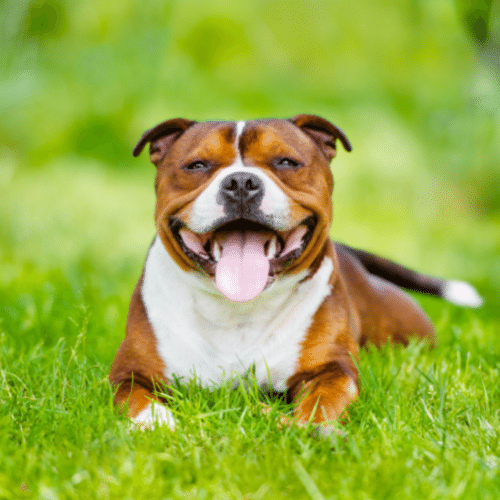
Compared to other purebred dogs, these canines are pretty healthy. They aren’t prone to the many different health problems like other breeds. Still, these dogs aren’t completely healthy. There are quite a few conditions that they can develop – just like any breed.
Hip dysplasia is one of the conditions that Pitbulls are often genetically predispositioned to. This condition is inherited and causes the joints not to form properly. There are some environmental factors that can cause this condition as well, such as improper nutrition and excessive exercise. Eventually, this will lead to excess wear on the dog’s joints and arthritis-like symptoms.
This can be treated with medication and sometimes surgery. Supportive care is also available, such as supplements.
The Tri-Color Pitbull can also run into problems with their patella (kneecap). Sometimes, the groove on their femur where their kneecap sits does not form properly. This makes the kneecap unable to sit perfectly in it, which can make it easier for it to pop out of place. This can cause pain and damage to the surrounding area if it is not treated properly.
Treatment for this can vary. Sometimes, arthritis medication is required because the kneecap will damage the femur when it pops out. Other times, surgery may be needed to realign the kneecap into the correct position.
Thyroid problems commonly occur as well. The thyroid gland makes many important hormones that are required for the body to work properly. However, occasionally, the thyroid does not make the proper amounts of these hormones. This can cause dry skin, hair loss, skin diseases, weight gain, fearfulness, aggression, and other strange behaviors. If your dog suddenly starts acting weird, it may be due to its thyroid.
Demodex mange is a common problem for these dogs. These mites live in the hair follicles of the dog, causing skin irritation and hair loss. In most cases, a dog’s immune system keeps the mites from getting out of hand. This leads to mild, localized cases of dry, irritated skin, which can be treated quite easily with the proper medication.
However, Pitbulls are often immunodeficient when it comes to this disease, which means that their immune system will not fight it off properly. This leads to the mange getting out of hand. The whole body can become infected. Bloody and scabby skin isn’t uncommon. Secondary infections may occur due to the constant open sores.
Specific medications can prevent the problem from getting too bad, but quick treatment is necessary. Many dogs will need lifelong maintenance. Usually, this disease isn’t deadly in itself, but the secondary infections could be if they are not tackled quickly.
Parvovirus is another disease that Pitbulls commonly have an immunodeficiency for. They are more likely to catch this disease when exposed and more likely to develop serious symptoms. Luckily, there is a vaccination for this disease. You simply need to make sure that your dog gets it and stay updated on shots.

This breed requires minimal grooming. Their coat is short and smooth. It does a pretty good job of keeping itself clean. They do shed a decent amount, however. For this reason, we recommend brushing them at least once a week. This will help remove this dead fur, as well as other dirt and debris. Keeping up with their regular brushing sessions will elongate the time your dog needs between a bath. It will also spread out their natural oils, which will help keep their fur and skin healthy.
These dogs may need a bath occasionally when they get physically dirty. Otherwise, you shouldn’t have to worry about it. If they roll in the mud, you should bathe them. Otherwise, you can wait until they start smelling a bit dingy, which will take months.
Like most dogs, you will also need to trim their nails and keep an eye on their ears. While they aren’t prone to ear infections, any dog’s ears will get infected if they are allowed to get dirty. Therefore, you will need to clean them with a damp cotton ball whenever you notice built-up dirt and grime. This is true no matter what ear type your dog has.
Dental care is important as well. Many dogs get periodontal problems, which can be extremely troublesome. This can lead to infections and other issues. Gum disease can provide a direct port for bacteria into the bloodstream, which can mess with their heart, kidneys, and other organs.
While Tri-Color Pitbulls aren’t particularly prone to dental problems, any dog will develop dental problems if their teeth are not cared for properly.
While Pitbulls are decently common throughout much of the United States, tri-color Pitbulls are not. This is a rare recessive gene that usually requires particular breeding. Therefore, it is difficult to find these dogs outside of a breeder. You’ll likely need to find a breeder that specializes in these colors.
Because this coloration is a bit rare, it can be a bit expensive. It largely depends on the breeder you purchase from, though. Some may charge as much as $35,000 for a puppy. Most puppies are around $5,000. It isn’t uncommon for the “1st pick” puppy to cost as much as $7000, though.
Of course, purchasing from a breeder is the most expensive option. You may be able to purchase from a rescue instead. However, this particular coloration is rare, so it can be particularly difficult to find from a rescue. Many of these dogs are often adults. Puppies are even rarer.
Most breeders are so expensive because they put a lot of money into their puppies. Health testing is common, which can get quite expensive. Many breeders health test parent dogs before they are bred together. This helps ensure that the adults don’t have any underlying conditions that are then passed onto their puppies. Some also perform testing on the puppies after they are born, ensuring that they aren’t carrying certain conditions.
Furthermore, many breeders know how to socialize their puppies properly. Most are raised in the home, which means that they will be used to common household noises. This makes them more adaptable to your home after adoption. After all, they’ll already know what a home is.
Most puppies also receive plenty of health care when adopted from a breeder. The puppy’s first vaccinations are usually covered by the breeder. The large majority of puppies are taken to the vet at least once before they are adopted. For this reason, they tend to be a bit more expensive. These prices often get wrapped into the cost of the puppies.
FAQ
What is the rarest tri color pitbull?
What is the rarest pitbull bloodline?
Colors like lilac and merle blue are the rarest.